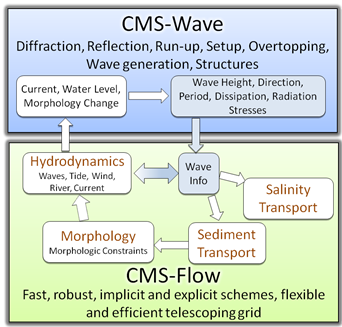CMS2D
CMS2D (Coastal Modeling System) is an integrated two-dimensional (2D) numerical modeling system for simulating waves, currents, water levels, sediment transport, and morphology change at coastal inlets and entrances (Sanchez et al. 2014). The system is designed for coastal inlets and navigation applications including channel performance and sediment exchange between inlets and adjacent beaches. It is developed and maintained by the Coastal Inlet Research Program (CIRP), Coastal and Hydraulics Laboratory, US Army Corps of Engineers Research and Development Center (ERDC), Vicksburg, Mississippi. CIRP is developing, testing, improving and transferring the CMS to Corps Districts and industry and assisting users in engineering studies. The overall framework of the CMS is depicted in the following ilustration.

CMS-Flow calculates depth-averaged hydrodynamics by solving the conservative form of the 2D shallow water equations using the finite volume method on a regular or quadtree (telescoping) Cartesian mesh, as well as hybrid triangular/quadrilateral mesh. The quadtree Cartesian grid splits a computational cell to four cells. Some important features and processes included are: wetting and drying, wave radiation stresses, surface roller stresses, wave mass fluxes, wave-enhanced bottom friction, turbulent diffusion, wall friction, Coriolis force, spatially variable wind and atmospheric pressure, and vegetation drag. Both explicit and implicit time marching schemes are available. The explicit scheme is designed for highly transient flow and extreme wetting and drying problems which require small time steps. The implicit scheme is designed for tidal flow and long-term simulations where large time steps can be used on the order of 10 min (Wu et al. 2011; Sanchez 2013).
The CMS-Flow is coupled with the spectral wave transformation model, CMS-Wave, which is used to simulate variations of wave-action density in time, space, wave direction and frequency. CMS-Wave solves the wave-action balance equation using a forward marching finite difference method (Mase et al. 2005; Lin et al. 2008). The considered physical processes include wave shoaling, refraction, diffraction, reflection, wave-current interaction, wave breaking, wind wave generation, white capping of waves, vegetation drag, and the influence of coastal structures. In addition, the wave surface roller is simulated by solving the steady-state energy balance equation.
CMS simulates multiple-sized sediment transport and the resulting bed change using the non-equilibrium total-load transport model (Sanchez and Wu 2011). The sediment transport capacity under combined currents and waves is calculated using five formulas: Lund-CIRP, Watanabe, Soulsby-van Rijn, van-Rijn, and Wu et al. Correction factors are used to account for the hiding and exposure effects of nonuniform sediment transport. The bed is divided into discrete vertical layers and the fractional composition of each layer is tracked in time.
CMS takes advantage of the Surface-water Modeling System (SMS) interface versions 8.2 through 11.1 for grid generation, model setup, plotting and post-processing of modeling results. Details of CMS can be found at http://cirp.usace.army.mil/products/cms.php
References:
A. Sanchez, W. Wu, H. Li, M. Brown, C. Reed, J.D. Rosati, and Z. Demirbilek (2014). “Coastal Modeling System: mathematical formulations and numerical methods.” ERDC/CHL TR-14-2, Coastal and Hydraulics Laboratory, U.S. Army Engineer Research and Development Center, Vicksburg, MS.
W. Wu, A. Sanchez, and M. Zhang (2011). “An implicit 2-D shallow water flow model on unstructured quadtree rectangular mesh.” Journal of Coastal Research, Special Issue, No. 59, pp. 15–26.
A. Sanchez (2013). “An implicit finite-volume depth-integrated model for coastal hydrodynamics and multiple-sized sediment transport.” PhD Dissertation, the University of Mississippi, USA.
A. Sanchez and W. Wu (2011). “A non-equilibrium sediment transport model for coastal inlets and navigation channels.” Journal of Coastal Research, Special Issue, No. 59, pp. 39–48.
L. Lin, Z. Demirbilek, H. Mase, J. Zheng, and F. Yamada (2008). “CMS-Wave: A nearshore spectral wave processes model for coastal inlets and navigation projects.” Technical Report ERDC/CHL TR-08-13, Coastal and Hydraulics Laboratory, ERDC, US Army Corps of Engineers, Vicksburg, MS, USA.
H. Mase, K. Oki, T.S. Hedges, and H.J. Li (2005). “Extended energy-balance-equation wave model for multidirectional random wave transformation.” Ocean Eng., 32(8-9): 961-985.